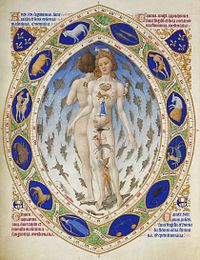
Photo from wikipedia
Saint Hildegard of Bingen (c. 1098-1179) was a 12th century Benedictine abbess, a visionary, a composer, a poet, a healer, and one of few medieval women who produced treatises on… Click to show full abstract
Saint Hildegard of Bingen (c. 1098-1179) was a 12th century Benedictine abbess, a visionary, a composer, a poet, a healer, and one of few medieval women who produced treatises on medicine. In her medical writings, Causae et curae and Physica, the abbess described, among other topics, physical functions and mechanisms of sleep, dreams and waking, emphasizing the importance of sleep for the human body. She regarded sleep as both a passive and an active process. Hildegard warned her readers about sleeping too little or too much, evaluated possible causes of insomnia and nightmares, and discussed potential treatments for these sleep disorders. In this paper, we analyze Hildegard's writings in the context of Greco-Roman physiological theories, which were held to the end of the Middle Ages and later. We also discuss questions concerning the abbess's putative education, the originality of her works, and the significance of her writings in the context of current knowledge on sleep medicine.
Journal Title: Sleep medicine
Year Published: 2021
Link to full text (if available)
Share on Social Media: Sign Up to like & get
recommendations!